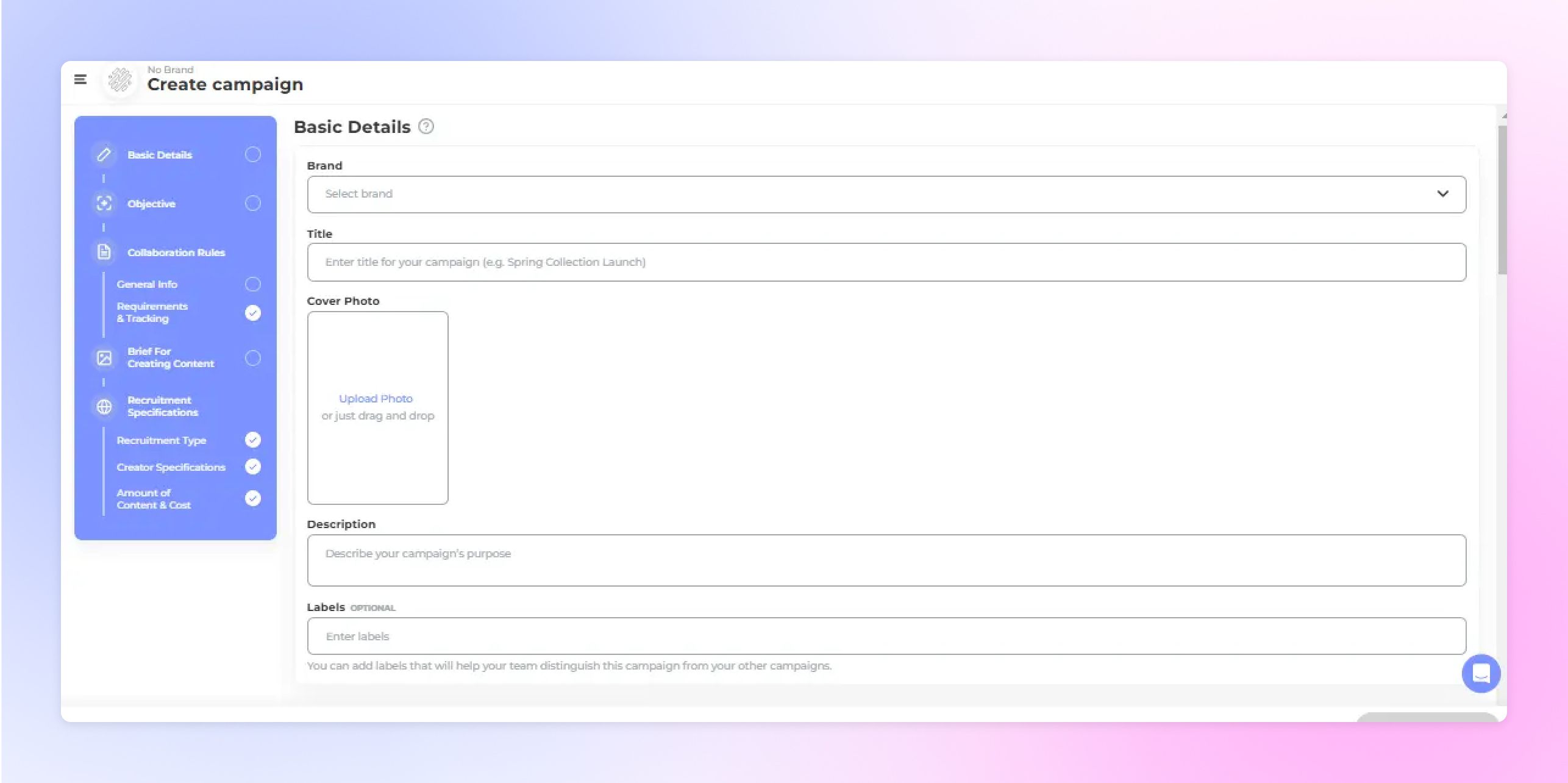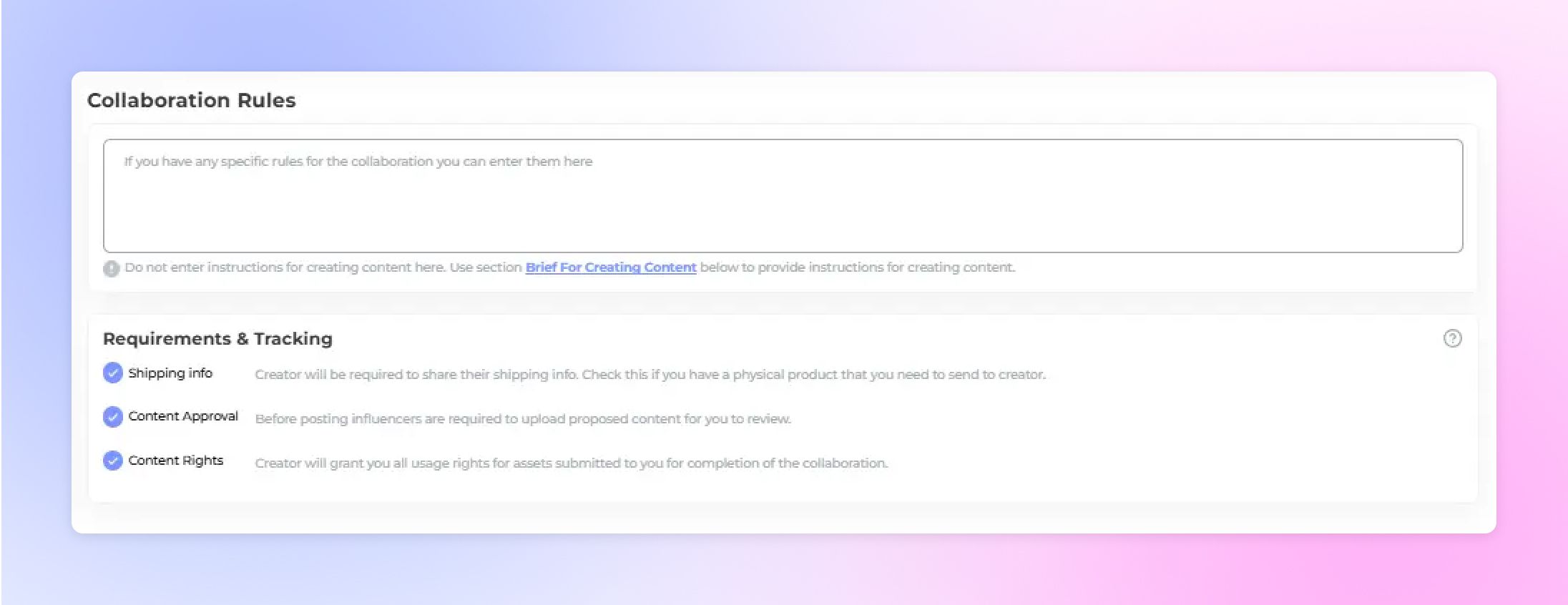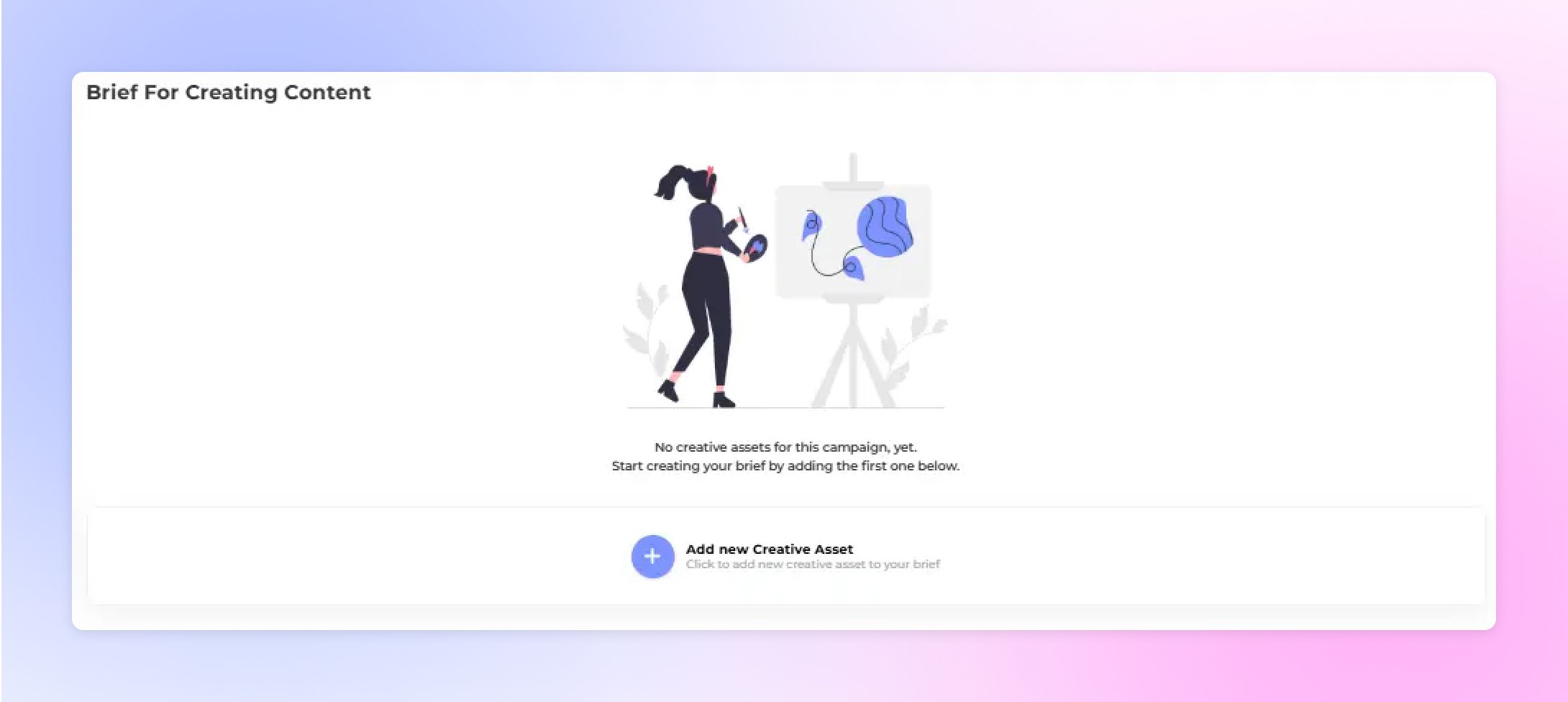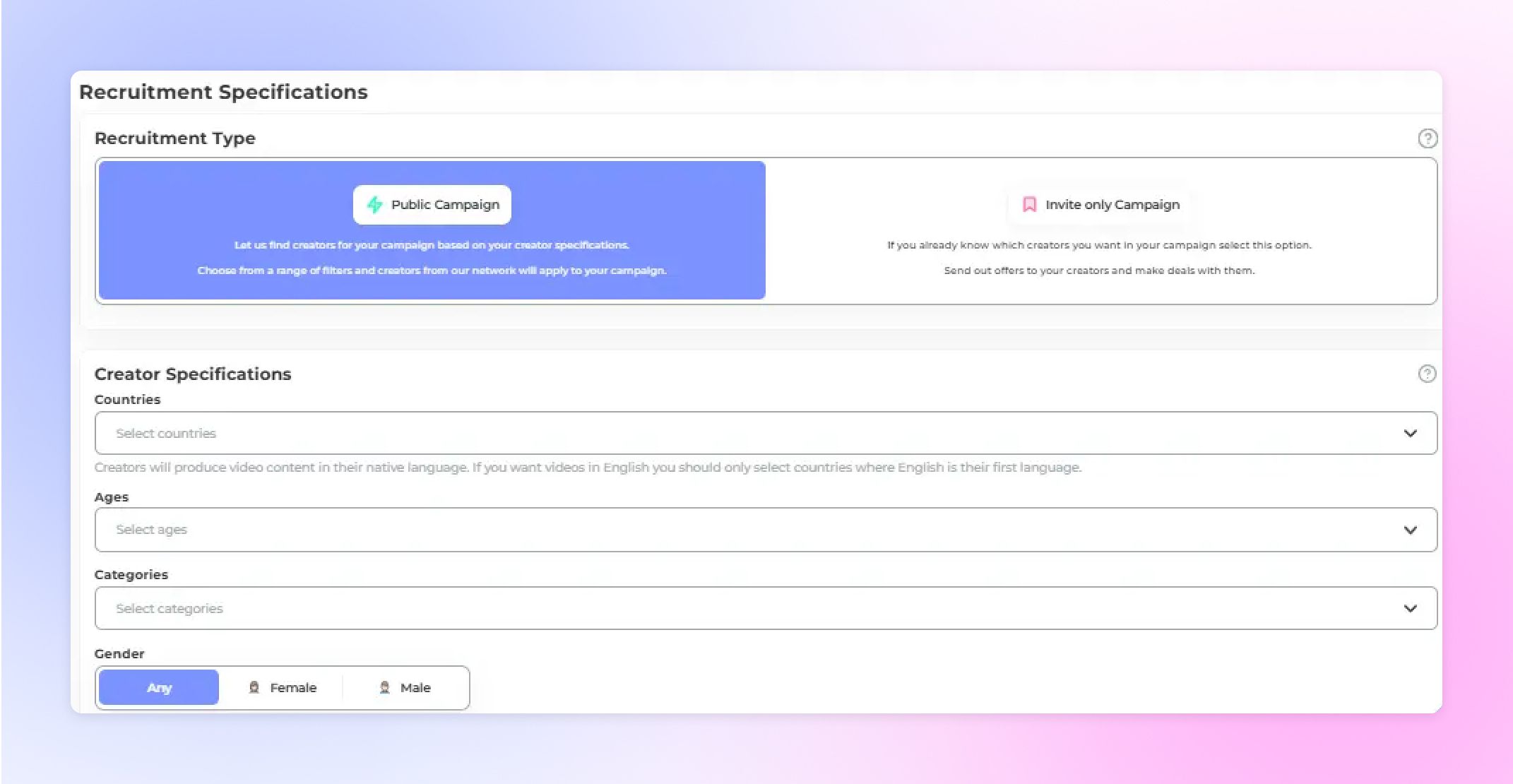
UGC Script: Stap-voor-stap handleiding met echte voorbeelden
January 17, 2025

Written By Katja Orel
Lead Editor, UGC Marketing
93% of marketers already say user-generated content (UGC) outperforms traditional branded content.
No surprise there, since 88% of people trust recommendations from others more than what brands say about themselves!
That’s the power of authentic content. And with a clear, effective brief, you can make use of it too.
Here, we will look at:
- What a UGC brief is and why it matters
- How to create one
- Examples of UGC briefs, right down to the script
- A template for creating a brief within Influee
Key Takeaways:
- A detailed UGC brief aligns creators with brand goals.
- Include brand info, campaign purpose, and deadlines.
- Specify deliverables: format, length, and platform. Provide a scene-by-scene script with hooks and CTAs.
- Share creative examples to inspire creators
UGC videos starting at $80

13000+ Vetted Creators in USA
What is a UGC Brief?
A UGC brief is a detailed document that tells creators what content you need and how to create it. A blueprint for the creative asset, ensuring the videos or photos meet your brand’s vision and goals.
This is your chance to communicate exactly what you want while giving creators the creative freedom they need.
Why Create a UGC Brief?
You can’t hit a target you don’t define. Whether you’re looking to boost brand awareness, drive conversions, or grow your social media presence, your UGC brief aligns everyone to a shared vision.
1. Clear Campaign Goals
Clear goals ensure every piece of content moves the needle. You don’t want to leave creators guessing, as it risks your campaign going off-course. The brief keeps your objectives front and center.
For example:
- Boosting awareness: Include hooks that grab attention, like “Did you know 70% of customers prefer eco-friendly products?”
- Driving sales: Highlight specific CTAs, such as “Shop now and save 20%!”
2. Clear Communication
Ambiguity kills creativity. A well-written brief leaves no room for misinterpretation, giving creators a clear picture of your expectations.
Specify every detail:
- Preferred tone of voice: Casual, professional, or witty?
- Platform specifications: TikToks, Reels. Instagram feed - indicate the target destination of the creative assets that will be prepared.
- Key talking points: What features or benefits do you want highlighted?
UGC videos starting at $80

13000+ Vetted Creators in USA
For instance, if you’re promoting a skincare product, your brief might say:
“Focus on the product’s natural ingredients and show a visible ‘before and after.’ Avoid overly polished looks—keep it real and relatable.”
That way creators can strike the perfect balance between following your vision and adding their personal touch.
3. Better, More Relevant Content
Generic content doesn’t sell. People connect with authenticity, but authenticity requires planning. A detailed UGC brief helps creators know your audience as well as you do.
- Demographics: Who is your audience? Are they busy parents, campus students, or teens?
- Interests: Are they into fitness, sustainability, or high-tech gadgets? Sports, health, fashion - every niche has its audience.
Example:
If you’re selling eco-friendly water bottles to young professionals, your brief might specify:
“Show the product in action—on a desk at work, during a morning yoga session, or clipped to a backpack while hiking. Highlight its durability and sustainability.”
Such authenticity is why UGC-based ads end up receiving 4x higher click-through rates than traditional ads.

4. Saves Time and Money
Revisions take a toll on productivity—and budgets. A solid UGC brief reduces back-and-forth, delivering polished content quickly.
- Without a brief: Creators submit a video with the wrong dimensions or tone, requiring reshoots.
- With a brief: You receive on-brand content in the correct format the first time.
And because the brief minimizes miscommunication, you can focus on scaling your campaign rather than wasting your time correcting mistakes.
How to Write a UGC Brief
To create a winning UGC brief, you need to include the following details:
1. About the Brand
Start by introducing your brand:
- Brand name: Make it unmistakable.
- Campaign purpose: Are you promoting a launch, boosting visibility, or running a seasonal campaign?
- Deadlines: Be clear about when you need the content.
Example:
For a jewelry brand launching a summer collection:
“We’re JewelShine, introducing our limited-edition Summer Dazzle collection. Content is needed by June 15th.”
2. Deliverables
Specify the objective and format of the content:
- Ready-to-run UGC video ads
- Raw footage
- Social media-ready videos
Example:
“We need three Instagram Reels highlighting the new collection in lifestyle settings.”
3. Content Requirements
Outline rules for collaboration, like how the brand logo will be displayed, style preferences, settings like the content should not have filters, etc.
4. Add Examples
Show creators what you have in mind with creative UGC examples. This inspires and sets the tone. You can link to a previous campaign or competitors’ UGC that nailed it.
- A video of someone unboxing a similar product.
- A quick clip showcasing a feature.
- A testimonial-style video with natural lighting.
These references set the tone while leaving room for creators to add their unique spin.
5. UGC Script
Include a script or prompts to guide creators. But ensure it feels authentic and unscripted.
Great scripts break content into clear, digestible scenes. Each part—hook, main content, and CTA—guides the creator while allowing flexibility.
For example:
Scene #1: Hook
Talking point: “Stop scrolling! You NEED to see this Summer Hat!”
Main footage: Someone putting on the hat just as they step out into bright sunlight.
Scene #2: Talking Points
Talking point: “This UV-protective hat saved my outdoor trips when on a hike at [location]”B-roll: Close-up of the hat's wide brim shielding the sun.
Scene #3: CTA
Talking point: “Limited-time offer: 15% off. Act fast!”B-Roll: A hand adjusting the hat for a perfect fit.
Breaking scripts this way lets creators know exactly what to do.
Use our UGC brief template for free to include a scene-by-scene script, hooks, talking points, and a compelling CTA.
See more UGC script examples.

6. Hooks
In a world of 1-second attention spans, you need a that grabs attention and keeps viewers engaged.
- “Why are 80% of people switching to this water bottle?”
- “Hate mornings? This gadget will change your life.”
Hooks should reflect the tone of your brand and target audience. Test multiple variations to find what resonates.
7. Talking Points
This is the meat of the script, where the product’s story comes alive. Use clear instructions for:
- Main footage: Describe the exact setup. For example: “Show yourself wearing the product during a hike.”
- B-Roll shots: Add visual variety. Example: “Film a close-up of the adjustable strap being fastened.”
Example Talking Point:
“This isn’t just a hat. It’s your all-day sunshield with adjustable fit and machine-washable material. Perfect for any adventure.”
The more specific you are, the easier it is for creators to deliver content that aligns with your vision.
8. CTA
Direct viewers to take the next step, aligning your UGC with marketing goals.
Make it easy and actionable:
- “Shop now at [brandsite.com] and save 20% this weekend.”
- “Hit the link below to grab yours before it’s gone.”
You might worry that scripts stifle creativity, but the opposite is true. They provide structure while leaving room for personality. Creators can focus on delivering their best work instead of second-guessing your expectations.
Want to whip up a quick script that hits the mark?
Use our FREE Magic Script Generator—a powerful AI tool designed exclusively for creating high-converting UGC ads tailored to your brand and product needs.
Our Exact UGC Brief Template
Here’s the step-by-step guide to filling out your brief using Influee’s Campaign Editor:

1. Basic Details
- Brand Name: [Indicate your brand name. e.g. JewelShine]
- Campaign Purpose: The description sets the tone. Use 150-200 words to explain your campaign’s purpose and highlight what makes your product special. Address creators directly to inspire them:
Example: “This campaign celebrates eco-friendly fashion. Showcase the versatility of our Summer Dazzle necklaces—perfect for brunches, beach days, and beyond. Help us spread the word about our commitment to sustainability!”
- Deadlines: Submit by [specific date].
- Title: Keep it simple and focused on the product, like "Summer Dazzle Launch." Avoid brand redundancy. Your brand name is already displayed, so save that space for compelling product specifics. Think short, sharp, and memorable.
- Cover Photo: Choose a high-quality, captivating image that features your product prominently. e.g.
- For a jewelry campaign, showcase a close-up of the piece worn in a relatable setting.
- For skincare products, opt for soft, clean aesthetics that highlight the product’s texture or packaging.
- Labels (Optional): Labels might seem minor, but they simplify internal organization. These tags keep your campaigns searchable, saving you time when managing multiple projects. e.g.
- Market-specific campaign labels: US, EU, Asia.
- Seasonal promotions: Black Friday, Summer Sale.
- Product launches like: Necklaces, New Collection.

2. Objective
Choose the content format that aligns with your goals.
Options include:
- Ready-to-run video ads: Perfect for sales-driven campaigns on Meta or TikTok. These ads are ideal for immediate use.
- Raw footage: This is your flexible option. Order unedited clips to test hooks, CTAs, or b-roll variations. It’s perfect for brands looking to experiment and optimize.
- Ready-to-post organic content: Here you have aesthetic TikToks, Instagram Reels, or YouTube Shorts. Use this for unboxing videos, lifestyle shots, or product demos that feel authentic and casual.
- Website content: Go to this for professional product showcases, review videos, or testimonial footage tailored to web audiences.

3. Collab Rules
This is your space to define the non-negotiables of your campaign. With clear rules, UGC content creators know where the boundaries are. It also keeps your brand image intact for a productive working relationship.
There are two sections here:
i. General Info
Include rules like
Tone and messaging
- “Maintain a friendly, approachable tone in all communications.”
- “Refrain from using offensive language or imagery in any content.”
Content exclusivity
- “Avoid featuring competitor products in the same campaign.”
- “Ensure the content is original and not repurposed from previous work.”
Brand representation
- “Always display the logo in a prominent position when featured.”
- “Keep the product as the focus—no unrelated distractions in the frame.”
Ethical standards
- “Do not misrepresent product features or make unverified claims.”
- “Respect privacy laws and avoid including personal identifiers without consent.”
Do not mix collaboration rules with specific creative instructions. Those belong in the “Brief for Creating Content” section. So don’t specify video formats or shot lists here. Save that for later.
ii. Requirements & Tracking
Logistics come in here, to ensure that all essential details are addressed upfront, and avoid hiccups later. Check the box that applies:
Shipping Info: If you’re launching a new skincare line, you would need the creator to receive the products in time for testing and filming. When you check this option:
- The creator provides their shipping details early.
- You can manage deliveries without delays, keeping your timeline intact.
Content Approval: How much control do you want over the publishing? By enabling content approval:
- Creators must submit their work for review before posting.
- You can provide feedback to refine content so it aligns perfectly with your brand's tone and goals.
Otherwise, the creator can post the content without your explicit go-ahead. Brands who have worked with creators for some time and have already built a rapport would be comfortable with it.
Content Rights: Creators grant usage rights to brands on Influee, which means:
- You can repurpose content across multiple platforms (e.g., websites, ads, and emails).
- There’s no need to renegotiate terms for future campaigns using the same content.
Using these tools upfront prevents miscommunication and you retain control over key aspects of the campaign.

Brief for Creating Content
Now for the core of the creative content.
1. Type
Select the most effective asset for your campaign.
- Review video: Great for unboxing or testimonials. Choose this if you want authentic, organic content without a b-roll. Example: A one-take video of a creator using your product and sharing honest thoughts.
- Raw footage: Ideal if you need multiple hooks, CTAs, or b-roll clips for in-house editing. Example: Close-up shots of your product, paired with a variety of angles.
- Video ad: High-conversion content, perfect for sales-driven campaigns on social media platforms. Includes hooks, talking points, a b-roll, and a CTA. In the United States, 80% of Gen Z consumers are already relying on UGC video ads before they make a purchase. We've compiled these and more UGC statistics.
- Photos: Aesthetic, brand-aligned stills for campaigns or social media. Specify lifestyle shots, close-ups, or flat lays. Example: A styled flat lay of your product surrounded by complementary items.
Your asset type should align with the option selected under your Objective.
For example, if you’re boosting conversions, opt for video ads with a clear call-to-action. If you aim for engagement, raw footage can help you A/B test hooks.
2. Product to Feature
Select the product that you want to be used/explained in the creative asset. Using product prioritization can help determine which product to feature first, ensuring your content highlights the most important or high-impact items.
Duration and Crop Options
Specifying the duration and crop for your video and photo content determines how well your content performs across platforms and with your target audience.
Video Duration:
- < 30 seconds: Great for quick, engaging ads with hooks and CTAs. Use this for TikTok, Instagram Reels, and Facebook Stories, e.g. for a fast-paced product highlight or promotional offer.
- < 60 seconds: Offers more room for storytelling or step-by-step demonstrations. Works well for slightly detailed review videos, like a testimonial showing how your product solves a problem.
- Long-form: Best for in-depth tutorials, unboxing, lifestyle stories, ideal for publishing on your site, platforms like YouTube or IGTV - like a full product demo showcasing features, benefits and use cases from a customer’s point of view.
Keep audience attention spans in mind. Stick to shorter durations for TikTok and Instagram while reserving long-form content for platforms that support extended engagement.
Crop Options for Video and Photo
Choose your preferred aspect ratio:
- Story (9:16)—Designed for full-screen immersive content on Instagram Stories, TikTok, and Snapchat. Best Use: Ads, product demos, or lifestyle moments.
- Vertical (4:5)— A slightly shorter vertical format perfect for feed posts on Instagram or Facebook.Best Use: Lifestyle or close-up photos, or highlighting products in day-to-day settings such as a morning coffee scene
- Square (1:1)— Balanced for both mobile and desktop. Ideal for Instagram feed posts and Facebook ads.Best Use: Close-ups, flat lays, or multi-product showcases, and creating beautifully arranged layouts, for websites or Pinterest.
- Landscape (16:9)—The classic format for YouTube and websites. Perfect for cinematic and professional content.Best Use: Tutorials, long-form videos, or horizontal layouts featuring products in context.
To simplify your creative process:
- Use < 30 seconds and Story (9:16) for engaging social media ads and reels.
- Opt for Square (1:1) when creating versatile content for Instagram and Facebook feeds. Use horizontal or square crops are great for creating beautifully arranged layouts, for websites or Pinterest.
- Go with Long Form and Landscape (16:9) for polished, professional YouTube videos or tutorials.
Work with this UGC brief template pdf to outline your preferences clearly, ensuring creators deliver exactly what you need.
3. Creative Script
A good video brief always includes a detailed script or clear prompts. Outline each scene.
Example:
Scene 1: Hook
- "Stop scrolling! This is your new favorite accessory."
- “Did you know your coffee habit could be killing your energy?”
- “Struggling to find a sunscreen that doesn’t leave a white cast?”
- “This hack saved me $200 on cleaning products!”
Scene 2: Main Content – Showcase the product’s adjustable clasp with a close-up. Include talking points of key product benefits and stats.
- “Contains 100% natural ingredients.”
- “Boosts energy levels by 60% in just two weeks.”
- “Customers report 95% satisfaction after first use.”
B-rolls are recommended to showcase the product in action:
- Pouring serum into hands, highlighting its smooth texture.
- A “before and after” comparison using the product.
- Lifestyle shots: Coffee on the desk with product in focus.
Scene 3: CTA
- "Shop now and enjoy 20% off this week!"
- “Click the link to shop now!”
- “DM us for a free sample!”
- “Hurry! Limited stock available.”
- “Transform your mornings—get yours today.”
You can also write a detailed list about the kind of content you’re looking for.
For example:
- Start with a close-up of the product box.
- Then shift to unboxing it while explaining its features.
- End with a friendly smile and a positive statement like, ‘This made my life easier!’
Some rules would need to be adaptable depending on how much room you're willing to give the creator. For instance, when it comes to the setting:
- Too rigid: “Only shoot in a studio with professional lighting.”
- Better: “Preferably shoot in natural light for an authentic feel, but studio shots are acceptable.”
Use a UGC brief template word or UGC brief template pdf to make specifying these details easier and faster.
4. Content References
Adding references helps creators understand your vision. This minimizes confusion and edit requests.
- Where to look: Use platforms like Meta Ad Library, TikTok Ad Library, or Influee’s Inspiration Hub to find top-performing ads.
- What to share: Include past successful campaigns, competitor examples, or high-engagement posts. Example: "Here’s a TikTok ad we love for its bright lighting and natural tone."

5. Recruitment Specifications
Next is finding the right creators for your campaign. Outline these specifications, you can ensure you attract creators who align with your brand’s goals and audience.
Recruitment Types
You can choose how to structure your campaign recruitment:
- Public campaigns: Open to all eligible creators on Influee. Great for discovering fresh talent and engaging a diverse pool of applicants.
- Invite-only campaigns: Limit your campaign to a handpicked group of creators that you already know. Ideal for when you want to work with proven influencers or specific niches.
Creator Specifications
This is where you narrow down your target creator profile.
- Country: Select creators from regions most relevant to your audience.Example: Target creators from the U.S., U.K., or Australia for a global product launch.
- Age range: Choose based on your product’s audience. Options include:
- Teen: For youth-oriented products like skincare or tech gadgets.
- Young adult: Perfect for fitness, travel, or lifestyle campaigns.
- Mature: Ideal for home, wellness, or professional products.
- Category/niche: Focus on creators in niches that resonate with your product, like parents, pet owners, or individuals in sports. This gets you into hyper-engaged communities.
Amount of Content & Cost
Specify the workload and budget for your campaign:
- Amount of creative assets per creator: Want two videos or five photos for your campaign? Define how many creative assets each creator must produce here. Influee gives you an Estimated Cost per Collaboration based on average payments on the platform.
- Number of creators: Indicate how many creators you need for the campaign.
UGC Brief Dos and Don’ts
Dos
- Be clear and concise.
- Provide visual examples.
- Use bullet points for readability.
Don’ts
- Don’t overwhelm creators with unnecessary details.
- Avoid vague instructions like “Just be creative.”
UGC videos starting at $80

13000+ Vetted Creators in USA
FAQ
Why do you need a UGC brief?
A UGC brief outlines your expectations so creators deliver spot-on video or photo content. Without it, creators might produce content that doesn’t align with your brand. That means more revisions, wasted time, and higher costs.
How do I brief a content creator?
Send them a detailed document as seen in the brief example here, covering:
- The story: Which product is to be covered? What's the message?
- Deliverables: Do you want ready-to-go review videos, raw footage that you can edit, or photos for your website or social media?
- Rules and brand guidelines: What to avoid (e.g., no logos, no distracting backgrounds).
How specific should you be about content requirements?
Detail every must-have, from lighting preferences (e.g., natural light only) to product shots (e.g., close-ups with hands holding the product). For example, “Show the bottle during a morning coffee routine.”
Use specific instructions. For example, say, “Highlight the product’s natural ingredients” instead of “Make it look good.” Mention tone (casual or witty?) and platform specs (e.g. TikTok feed or Instagram Reels).
How do you structure a creator-friendly UGC script?
Break it into scenes! Start with an attention-grabbing hook. Then, show the product in action—like applying sunscreen by the poolside—and wrap it with a strong CTA like, “Shop now for 20% off!” A clear structure makes everything flow.
Can UGC briefs save you money?
Absolutely. Revisions put more strain on the budget. A great brief reduces back-and-forth by aligning creators from the start and cutting production time. That’s time and money saved for scaling your campaigns.
How do you find the right creators for your campaign?
Be specific about who you want. Define their niche, age group, and even location. Example: “Eco-conscious women, 25-40, based in the U.S., with a love for minimalistic style.” The right creators speak directly to your target audience.
What’s the difference between UGC and influencers?
UGC is authentic content by real users, while influencers have curated personas. UGC is raw and relatable; influencers bring star power. Choose UGC when you want trust and relatability. Influencers on the other hand give you an instant boost in reach and credibility. Learn more in our analysis of UGC vs Influencers.
How to write a TikTok brief?
TikTok’s fast-paced environment means keeping things bite-sized and relatable. Include:
- Hook: Think, “Stop scrolling—this hack is life-changing!”
- Format: Always vertical, with trendy edits.
- Tone: Native, fun, and casual. Example: “Show off the product in action, add a cool transition, and end with a strong CTA like, ‘Try it now!’”
How do you handle UGC deliverables and deadlines?
Be specific in your brief. Outline:
- What: 1 testimonial video + 3 B-roll shots.
- When: Delivered by [this date]. Example: “We need an Instagram-ready reel (vertical, 30 sec) featuring a testimonial and product use by July 15th”
What’s the fastest way to make a UGC brief?
Use templates. Seriously, they save time and headaches. Try the UGC brief template download to plug in details like content type, tone, and deadlines. That way, nothing gets missed.
Table of Contents
Wat is een UGC-brief?
Waarom een UGC-brief opstellen?
Hoe je een UGC-brief schrijft
Onze nauwkeurige UGC-briefsjabloon
UGC beknopte do's en don'ts
FAQ

Work with UGC creators from  USA
USA

 USA
USA

Devin
Santa Rosa Beach

Samantha
Wilmington

Philip
Frisco

Courtney
Plover
